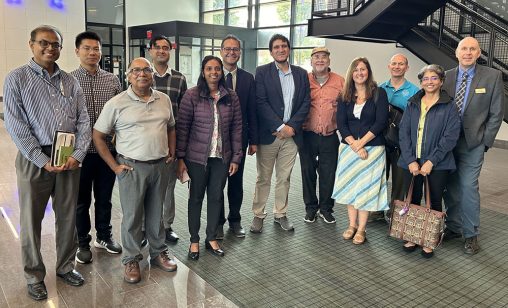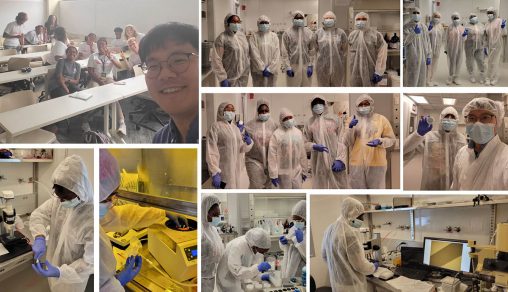
Project managers for Intel’s Semiconductor Education and Research Program for Ohio toured Wright State’s laboratories and discussed the Wright State-Central State summer advanced manufacturing training program.
Representatives from the Intel Corporation visited Wright State University this fall to tour its lab spaces and discuss opportunities to prepare more students for careers in semiconductor manufacturing and microelectronics.
Project managers for Intel’s Semiconductor Education and Research Program for Ohio toured Wright State’s additive manufacturing lab, digital microelectronics lab and Assured Digital Microelectronics Education and Training Ecosystem space in the Russ Engineering Center; the Appenzeller Visualization Laboratory in the Joshi Research Center; and the state-of-the-art cleanroom in the Neuroscience Engineering Collaboration Building.
Faculty members from Wright State and Central State University also gave a presentation on the inaugural Intel summer internship program for women and students from under-represented populations.
The internship program is part of Wright State’s collaboration with Central State to help it build a semiconductor educational program and a microelectronics lab and provide experiential learning opportunities for underrepresented undergraduate STEM students.
The program is supported by Intel, which awarded grants to several Ohio colleges and universities to help address the research and workforce needs of the growing semiconductor and microelectronic industries in the state. Intel is building two chip factories near Columbus.
Last summer, Wright State hosted the first cohort of Central State students for a five-course, two-month internship program.
The students received comprehensive hands-on training in cleanroom operations, microelectronics design and fabrication, 3D printing capabilities, and semiconductor integrated circuits security and trust.

Last summer, Wright State hosted the first cohort of Central State students for a two-month internship program during which they received training in advanced manufacturing techniques.
During the Intel visit, faculty members from Wright State and Central State discussed opportunities to expand the summer internship program so that more students can participate, said Subhashini Ganapathy, Ph.D., professor and chair of biomedical, industrial and human factors engineering and chair of Wright State’s Intel Initiative.
“We want to see how we can serve more students from under-representative populations,” she said. “How can we bring in more partners to contribute to developing workforce development training in semiconductor manufacturing and microelectronics?”
With Intel’s support, the Wright State-Central State collaboration is setting up microfabrication and simulation facilities that will play a pivotal role in advancing education and research in the field of semiconductors.
This collaborative effort is dedicated to preparing a diverse and well-equipped technical workforce to support the growth and competitiveness of the semiconductor industry, said Fathi Amsaad, Ph.D., assistant professor of computer science at Wright State.
“We are committed to ensuring sustainability by targeting further research and education funding opportunities in the semiconductor domain,” he said.
In addition to its partnership with Central State, Wright State is collaborating with 12 other regional universities and community colleges in the Ohio-southwest Alliance on Semiconductors and Integrated Scalable-Manufacturing. Wright State is one of four leadership universities in the alliance, which is led by the University of Cincinnati.
Institutions in the alliances are working together to develop new curriculum and experiential learning opportunities to prepare students for careers in semiconductor manufacturing.

 Milling around
Milling around  Wright State recognizes Nursing Professor Kim Ringo for advancing international student success
Wright State recognizes Nursing Professor Kim Ringo for advancing international student success  Wright State honors graduating students for distinguished doctoral dissertations
Wright State honors graduating students for distinguished doctoral dissertations  Top 10 Newsroom videos of 2025
Top 10 Newsroom videos of 2025  Museum-quality replica of historic Hawthorn Hill donated to Wright State
Museum-quality replica of historic Hawthorn Hill donated to Wright State 